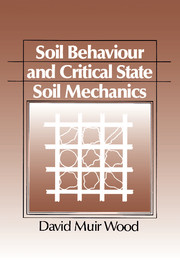Book contents
- Frontmatter
- Dedication
- Contents
- Preface
- Acknowledgements
- List of symbols
- 1 Introduction: models and soil mechanics
- 2 Elasticity
- 3 Plasticity and yielding
- 4 Elastic-plastic model for soil
- 5 A particular elastic—plastic model: Cam clay
- 6 Critical states
- 7 Strength of soils
- 8 Stress—dilatancy
- 9 Index properties
- 10 Stress paths and soil tests
- 11 Applications of elastic—plastic models
- 12 Beyond the simple models
- References
- Index
3 - Plasticity and yielding
Published online by Cambridge University Press: 05 October 2014
- Frontmatter
- Dedication
- Contents
- Preface
- Acknowledgements
- List of symbols
- 1 Introduction: models and soil mechanics
- 2 Elasticity
- 3 Plasticity and yielding
- 4 Elastic-plastic model for soil
- 5 A particular elastic—plastic model: Cam clay
- 6 Critical states
- 7 Strength of soils
- 8 Stress—dilatancy
- 9 Index properties
- 10 Stress paths and soil tests
- 11 Applications of elastic—plastic models
- 12 Beyond the simple models
- References
- Index
Summary
Introduction
The behaviour of an elastic material can be described by generalisations of Hooke's original statement, ut tensio sic vis: the stresses are uniquely determined by the strains; that is, there is a one-to-one relationship between stress and strain. Such a relationship may be linear or non-linear (Fig. 3.1), but an essential feature is that the application and removal of a stress leaves the material in pristine condition and no nett energy is dissipated.
For many materials the overall stress:strain response cannot be condensed into such a unique relationship; many states of strain can correspond to one state of stress and vice versa. For example, the first loading of an annealed copper wire in simple tension may follow a curved load:deformation path which is not retraced when the load is removed, but the wire is left with a permanent extension under zero load (AA1B1 in Fig. 3.2, from Taylor and Quinney, 1931). If the wire is reloaded to loads less than the previous maximum load, then an essentially elastic response is observed (B1C1 in Fig. 3.2, though there is a slight departure from the unloading path as the previous maximum load is approached), that is, there is a one-to-one relation between load and deformation. As soon as the previous maximum load is exceeded, the elastic description of the response ceases to apply and unloading from a higher load leaves the wire with a further permanent extension (B1C1A2B2 in Fig. 3.2).
- Type
- Chapter
- Information
- Soil Behaviour and Critical State Soil Mechanics , pp. 55 - 83Publisher: Cambridge University PressPrint publication year: 1991
- 1
- Cited by



